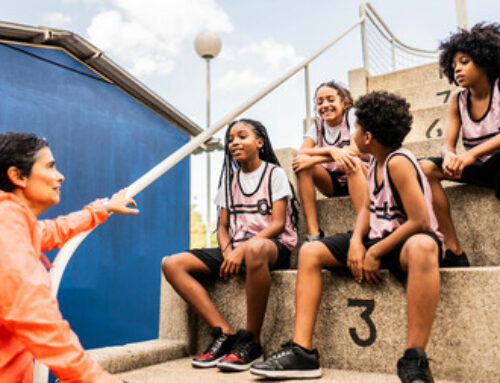Why Most Athletes’ Recovery Priorities Are Completely Out of Whack
Every athlete is looking for their ticket to the top. The latest trend in which many young have become invested is recovery. Athletes are spending countless amounts of money and time to schedule appointments for things like cupping and cryotherapy.
Tons of coaches have heard their athletes talk about the cryotherapy facility their buddy goes to, or the masseuse their aunt swears by. I can’t tell you how many conversations I’ve had like this:
Athlete: “Hey coach, I really want to try out cryo! I think it’ll help out my recovery.”
Me: “Alright, but first how much sleep did you get last night?”
Athlete: “5 maybe 6 hours. I’m too busy to sleep more.”
Me: “And how’s your diet? Eating breakfast?”
Athlete: “Nah, I can’t afford eating healthy. Plus, I don’t have time to eat breakfast.”
This athlete wants to spend the time to schedule an appointment and spend upwards of $40 on a cryotherapy session, but they supposedly don’t have time to sleep enough or the money to eat right. Well, why the heck would you further cram your busy schedule and burn money on this technique that, at best, will provide a tiny bit of benefit? This athlete has already demonstrated that they’re shortchanging the biggest components of recovery (rest and nutrition), which will always have a far bigger impact than any fancy recovery modality. But they saw their favorite athletes and friends using the cool new way to recover and figured they needed it, too.
The vast majority of young athletes don’t need to waste their (or their parents’) time and money scheduling recovery-oriented services or dropping hundreds on the latest recovery item. Because honestly, most will get far more from another hour of sleep each night or eating an extra snack during their daily routine than any of these methods. Nothing compares to the power of adequate rest and nutrition when it comes to recovery, yet young athletes consistently sell these short.
An abstract presented at the 2012 American Academy of Pediatrics National Conference found that adolescent athletes who slept eight or more hours a night were 68% less likely to be injured than athletes who regularly slept less! And more sleep won’t just help you stay out of the trainer’s room—it’ll help you play better, too. A 2011 study found that basketball players at the University of Stanford increased their free-throw percentage by an average of 9 percent and their 3-point percentage by an average of 9.2 percent simply by extending their amount of daily sleep. They also sprinted faster, reported less fatigue and believed they played better in both practice and games.
“If you told an athlete you had a treatment that would reduce the chemicals associated with stress, that would naturally increase human growth hormone, that enhances recovery rate, that improves performance, they would all do it,” Dallas Mavericks head athletic trainer Casey Smith told ESPN. “Sleep does all of those things.”
The young athlete will often say that they feel totally fine on the sleep they are getting, which is likely because it has been so long since they’ve been truly rested that they’ve forgotten what it feels like to be fresh. Pro athletes are susceptible to this, too. In a 2019 study published in Sleep Health, researchers found that late night tweeting (tweets posted after 11 p.m.) before a game led NBA players to shoot 1.7 percent worse on average than games they hadn’t preceded with late night tweets.
On the other side of the coin is nutrition. A 2015 study found that more than 50% of American teens and children are at least mildly dehydrated, while 25% of them don’t drink any water on a daily basis. Being even a little dehydrated has negative impacts on mood, energy levels, reaction time and focus! Most young athletes are also chronically under-fueled. Teen athletes burn a humongous number of calories, yet so many of them skip breakfast or don’t eat any snacks throughout the day. Simply eating more is enough for many teen athletes to feel remarkably better and make huge changes in their body.
A 2019 article in the Journal of Strength and Conditioning Research found that athletes who were made to skip breakfast performed 15 percent fewer reps on the Back Squat and 6 percent fewer reps on the Bench Press when compared to athletes who were given breakfast. Athletes skipping breakfast are potentially missing out on hundreds of reps over the course of an offseason!
Although there’s a mountain of research backing the importance of things like good sleep, hydration and nutrition and their impact on athletic performance, the research on many recovery methods is far from conclusive. A 2017 article in the Journal of Strength and Conditioning Research found there were no performance benefits or perceptual benefits of cryotherapy when compared to a control. There was a testosterone increase, but the researchers concluded that it’s still unclear if that was significantly useful.
When it comes to recovery, what youth athletes really need to do is sleep, eat and relax. The rest is just window dressing, and many simply aren’t worth the stress. If you have all the basics on point, can you do more recovery? Sure. But that applies to very few young athletes, and no amount of tech or treatments will ever replace rest, relaxation and good eating. Master the basics and watch your performance soar.
Some practical tips athletes should use to help improve the basics:
- Wake up and go to sleep at the same time each day.
- Avoid electronics 30 minutes before bed and make your room as dark as possible.
- Eat breakfast every morning.
- Bring a snack to school.
- Include fats, proteins and carbs in every meal.
The benefit of every recovery tool added together still can’t replace what a good night’s sleep, proper nutrition and time doing nothing can offer an athlete. If you’ve got a ton going on, simply finding more time to rest and do nothing will enhance your recovery. While flashy marketing might make you believe otherwise, lock in on the basics before you worry about anything else.
Photo Credit: digitalskillet/iStock
READ MORE:
RECOMMENDED FOR YOU
Why Most Athletes’ Recovery Priorities Are Completely Out of Whack
Every athlete is looking for their ticket to the top. The latest trend in which many young have become invested is recovery. Athletes are spending countless amounts of money and time to schedule appointments for things like cupping and cryotherapy.
Tons of coaches have heard their athletes talk about the cryotherapy facility their buddy goes to, or the masseuse their aunt swears by. I can’t tell you how many conversations I’ve had like this:
Athlete: “Hey coach, I really want to try out cryo! I think it’ll help out my recovery.”
Me: “Alright, but first how much sleep did you get last night?”
Athlete: “5 maybe 6 hours. I’m too busy to sleep more.”
Me: “And how’s your diet? Eating breakfast?”
Athlete: “Nah, I can’t afford eating healthy. Plus, I don’t have time to eat breakfast.”
This athlete wants to spend the time to schedule an appointment and spend upwards of $40 on a cryotherapy session, but they supposedly don’t have time to sleep enough or the money to eat right. Well, why the heck would you further cram your busy schedule and burn money on this technique that, at best, will provide a tiny bit of benefit? This athlete has already demonstrated that they’re shortchanging the biggest components of recovery (rest and nutrition), which will always have a far bigger impact than any fancy recovery modality. But they saw their favorite athletes and friends using the cool new way to recover and figured they needed it, too.
The vast majority of young athletes don’t need to waste their (or their parents’) time and money scheduling recovery-oriented services or dropping hundreds on the latest recovery item. Because honestly, most will get far more from another hour of sleep each night or eating an extra snack during their daily routine than any of these methods. Nothing compares to the power of adequate rest and nutrition when it comes to recovery, yet young athletes consistently sell these short.
An abstract presented at the 2012 American Academy of Pediatrics National Conference found that adolescent athletes who slept eight or more hours a night were 68% less likely to be injured than athletes who regularly slept less! And more sleep won’t just help you stay out of the trainer’s room—it’ll help you play better, too. A 2011 study found that basketball players at the University of Stanford increased their free-throw percentage by an average of 9 percent and their 3-point percentage by an average of 9.2 percent simply by extending their amount of daily sleep. They also sprinted faster, reported less fatigue and believed they played better in both practice and games.
“If you told an athlete you had a treatment that would reduce the chemicals associated with stress, that would naturally increase human growth hormone, that enhances recovery rate, that improves performance, they would all do it,” Dallas Mavericks head athletic trainer Casey Smith told ESPN. “Sleep does all of those things.”
The young athlete will often say that they feel totally fine on the sleep they are getting, which is likely because it has been so long since they’ve been truly rested that they’ve forgotten what it feels like to be fresh. Pro athletes are susceptible to this, too. In a 2019 study published in Sleep Health, researchers found that late night tweeting (tweets posted after 11 p.m.) before a game led NBA players to shoot 1.7 percent worse on average than games they hadn’t preceded with late night tweets.
On the other side of the coin is nutrition. A 2015 study found that more than 50% of American teens and children are at least mildly dehydrated, while 25% of them don’t drink any water on a daily basis. Being even a little dehydrated has negative impacts on mood, energy levels, reaction time and focus! Most young athletes are also chronically under-fueled. Teen athletes burn a humongous number of calories, yet so many of them skip breakfast or don’t eat any snacks throughout the day. Simply eating more is enough for many teen athletes to feel remarkably better and make huge changes in their body.
A 2019 article in the Journal of Strength and Conditioning Research found that athletes who were made to skip breakfast performed 15 percent fewer reps on the Back Squat and 6 percent fewer reps on the Bench Press when compared to athletes who were given breakfast. Athletes skipping breakfast are potentially missing out on hundreds of reps over the course of an offseason!
Although there’s a mountain of research backing the importance of things like good sleep, hydration and nutrition and their impact on athletic performance, the research on many recovery methods is far from conclusive. A 2017 article in the Journal of Strength and Conditioning Research found there were no performance benefits or perceptual benefits of cryotherapy when compared to a control. There was a testosterone increase, but the researchers concluded that it’s still unclear if that was significantly useful.
When it comes to recovery, what youth athletes really need to do is sleep, eat and relax. The rest is just window dressing, and many simply aren’t worth the stress. If you have all the basics on point, can you do more recovery? Sure. But that applies to very few young athletes, and no amount of tech or treatments will ever replace rest, relaxation and good eating. Master the basics and watch your performance soar.
Some practical tips athletes should use to help improve the basics:
- Wake up and go to sleep at the same time each day.
- Avoid electronics 30 minutes before bed and make your room as dark as possible.
- Eat breakfast every morning.
- Bring a snack to school.
- Include fats, proteins and carbs in every meal.
The benefit of every recovery tool added together still can’t replace what a good night’s sleep, proper nutrition and time doing nothing can offer an athlete. If you’ve got a ton going on, simply finding more time to rest and do nothing will enhance your recovery. While flashy marketing might make you believe otherwise, lock in on the basics before you worry about anything else.
Photo Credit: digitalskillet/iStock
READ MORE:










